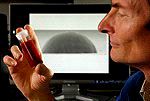Consumables
Xerox Unveils Revolutionary Cured Gel Ink for Next-Generation Commercial Printing Systems

Monday 02. June 2008 - Ink transforms from consistency of peanut butter to rock hard; prints on virtually any surface
Xerox Corporation (NYSE: XRX) today previewed a cured gel ink technology that prints on materials like plastic and foil, enabling digital printers to compete in areas like packaging to capture even more of the traditional offset print jobs making up the estimated $400 billion market.
“Today digital systems shine in many applications while offset presses are selected for others. The ability to print on nearly any surface will bring a world of new applications within reach of digital printers,” said Steve Hoover, vice president and director of the Xerox Research Center Webster. “Cured gel ink systems combine the best of both – the speed, low-cost and ability to print on varied materials like offset, and the personalization of digital.”
Showcased here at drupa, the print industry’s largest conference and exhibition, the new cured gel ink holds its shape on nearly any surface because it is not water-based like traditional inkjet technologies. The gel ink has the consistency of peanut butter after it is jetted through the print heads and turns rock hard when exposed to a pulse of ultraviolet light. The result is a crisp, vivid, and long lasting image. Unlike current water or solvent-based inkjet systems, the gel ink won’t bleed-through or require dryers and vapor recovery systems, thereby increase print speeds and making the system more environmentally friendly. Developed by scientists at the Xerox Research Centre Canada, the cured gel inks are based on Xerox’s proprietary solid ink technology.
In addition to the ink itself, the Xerox print heads, which determine drop size, reliability and imaging speed, are also at the heart of the new technology. With 10 times the life of a thermal inkjet print head, the Xerox heads are made from stainless steel in a modular, scalable and sturdy design. The individual print head module can jet over 40 million drops of ink in a second, supporting high-speed production. Individual modules fit together seamlessly to create wider prints.
“The technology is still in the research phase,” Hoover said, “but it is clearly an innovation that will take inkjet beyond the products and applications available today. These cured gel inks will set a new benchmark for performance, print surface options and image quality.”
Beyond traditional high-volume printing jobs such as brochures, posters, and catalogs, Xerox foresees an almost limitless market for its new technology. The high image quality on low cost paper will be appealing in what are called transpromo applications that combine bills or invoices with marketing messages in one document. The ability to print on cardboard without precoating, or on plastic films or foils will suit packaging applications, and direct mailers can save on mailing costs by using lighter weight papers without show through.
